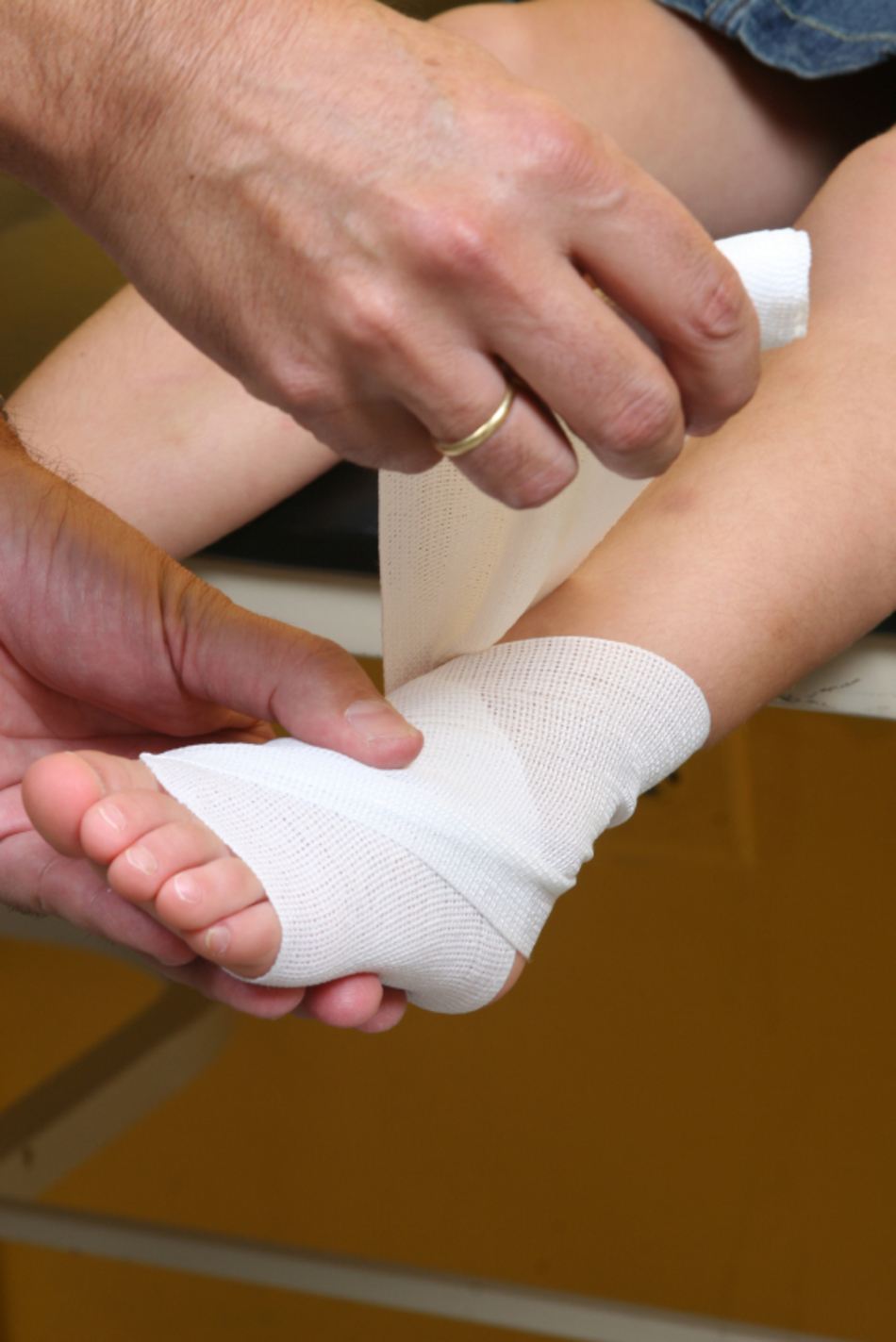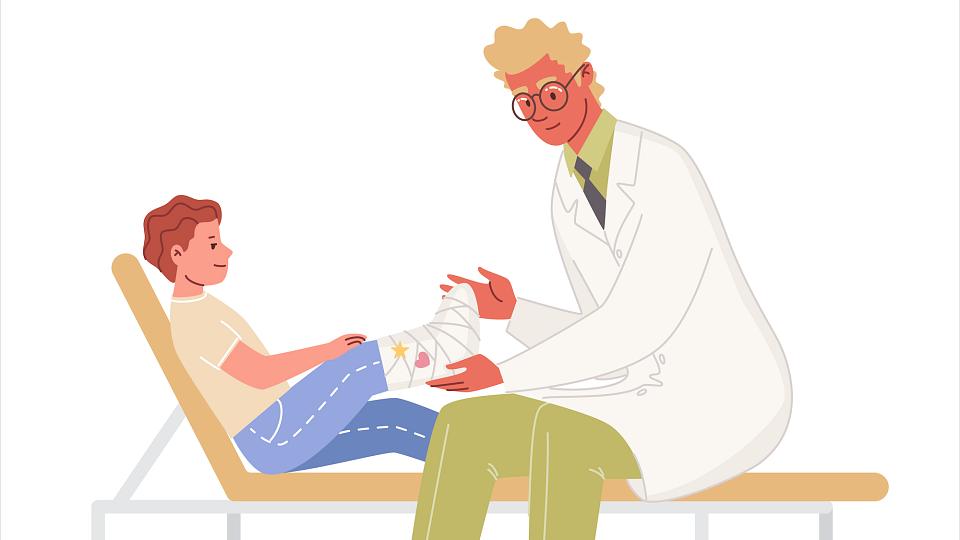
Dr. Gellner: It's time for back to school and sports and that means it's time for ankle sprains. How to help with this frequent sports injury is today's topic on The Scope. I'm Dr. Cindy Gellner.
Announcer: Keep your kids healthy and happy. You are now entering the Healthy Kid Zone with Dr. Cindy Gellner on The Scope.
What Is a Sprained Ankle?
Dr. Gellner: We're seeing a lot of kids that are going to back to school training camps for football, soccer, all sorts of sports that can twist up the ankle really quickly. So what exactly is an ankle sprain? Well, it's an injury that causes a stretch or tear in one or more ligaments in the ankle joint. Ligaments are strong bands of tissue that connect bones to the joint. There are many ligaments in an ankle.
The most common type of sprain involves the ligaments on the outside part of the ankle. That's the lateral ankle sprain. Ligaments on the inside of the ankle may also be injured, those are medial ankle sprains, as well as ligaments that are high and in the middle of the ankle, those are called high ankle sprains. Again, a sprain is caused by twisting your ankle. Your foot usually turns in or underneath you as you're walking, running, jumping, but it may also turn to the outside as well.
Sprains can be mild, moderate, or severe, but they all hurt. Symptoms of a sprained ankle include anything from mild aching to sudden pain, swelling, and bruising, which may look quite severe. You may have pain in the ankle even when you are not putting any weight on it.
Sprained Ankle Symptoms
To diagnose a sprained ankle, your child's pediatrician will ask about your child's symptoms and how the injury occurred. So it's very important you know what happened at the time of the injury. That's very important to the pediatrician. They'll also examine your child's ankle and if needed, X-rays may be taken depending on the severity of the symptoms.
Treatments for a Sprained Ankle
Treating a sprained ankle depends on how bad the sprain is. It can be remembered as the letters RICE, rest, ice, compression, and elevation. When your child first sprains their ankle, have them rest. Then, put an ice pack or package of frozen vegetables wrapped in a cloth on the area every three to four hours, for up to 20 minutes at a time. Raise the ankle with a pillow when sitting or lying down. And for compression, you can use an elastic bandage or even a brace that you can buy at your local store. Finally, keep your ankle elevated as much as you can for the first 72 hours.
If the sprain is severe, your child may need to use crutches until they can walk without pain. For the pain, your child can take an anti-inflammatory such as Ibuprofen or Naproxen, which is Aleve. Unless recommended by your pediatrician, do not take this pain medication for more than 10 days. Rarely, severe ankle sprains with complete tearing of the ligaments will need surgery. Your pediatrician will refer your child to an orthopedic doctor if that's the case. After surgery, your ankle will be in a cast for four to eight weeks.
Sprained Ankle Recovery Time
Recovery time depends on many factors such as how old your child is, what kind of health they're in, if they've ever had a previous ankle injury, and the severity of the sprain. A mild ankle sprain may recover within a few weeks whereas the severe sprain may take six weeks or longer to recover even if it doesn't require surgery. Recovery also depends on which ligaments were torn. The lateral sprain, remember those outside ligaments, takes less time to recover than a medial sprain, the inside ligaments, or a high ankle sprain, the high middle ligaments.
We often get asked, "When can my child go back to playing sports?" Well, everyone recovers from an injury at different rates. Your child can return to the activities depending on how soon the ankle recovers, not by how many days or how many weeks it's been since the injury occurred. In general, the longer your child has symptoms before he starts getting treatment, the longer it will take to get better.
The goal is to return to his normal activities as soon and safely as possible. If your child returns too soon, they may worsen their injury. Your child may safely return to normal activities when they have a full range of motion in the injured ankle compared to the uninjured ankle. Also, they need to have full strength in the injured ankle compared to the not injured ankle and they need to be able to walk straight ahead without pain or limping.
How to Prevent Ankle Sprains
For kids who are very active in sports, it's really important to try to remember how to prevent ankle sprains from happening in the first place. Be sure to have your child wear proper, well-fitting shoes, stretch before and after sports, avoid sharp turns and quick changes in direction, and consider taping their ankles or wearing an ankle brace during strenuous sports, especially if they've had a previous injury. If your child is a very athletic child, I can guarantee you they're going to have an ankle sprain. The most important thing is to address it right away, not wait, and let them recover before they get back out on the field.
Announcer: thescoperadio.com is University of Utah Health Sciences Radio. If you like what you heard, be sure to get our latest content by following us on Facebook. Just click on the Facebook icon at thescoperadio.com.
Learn More About Pediatric Sports Medicine & Orthopedics
Seven Questions for a Pediatric Orthopedic Surgeon
On this episode of Seven Questions for a Specialist, pediatric orthopedic surgeon Joshua Speirs, MD, shares insights into the typical diagnoses he encounters, debunks common misconceptions about pediatric orthopedics...





